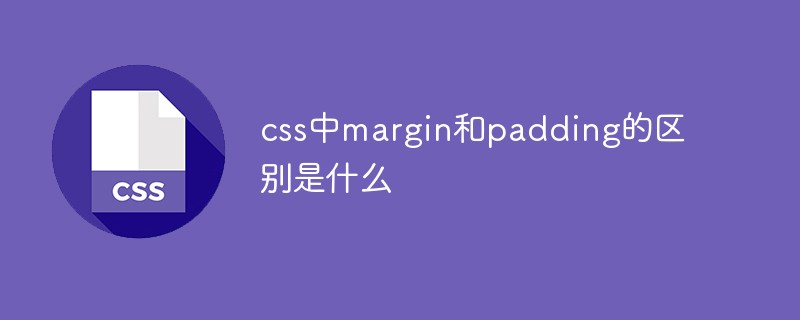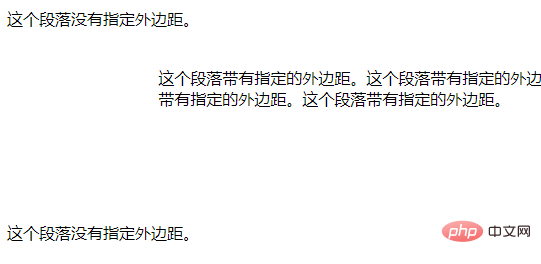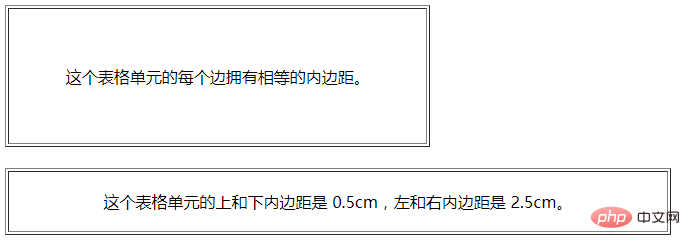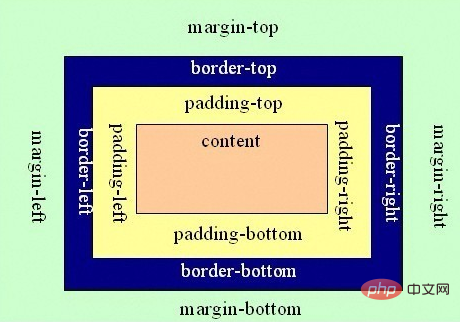What is the difference between margin and padding in css
The difference between margin and padding in css is: margin refers to the distance from its own frame to the border of another container, which is the outer margin of the container; padding refers to the distance from its own frame to the border of another container inside itself The distance between them is the inner margin of the container.

The operating environment of this tutorial: Windows 10 system, CSS3&&HTML5 version, Dell G3 computer.
What is the difference between margin and padding in css
1. The margin abbreviation attribute sets all margin attributes in one statement. This attribute can have 1 to 4 values.
This shorthand property sets the width of all margins of an element, or sets the width of margins on each side.
The vertically adjacent margins of block-level elements will be merged, while inline elements will not actually occupy the top and bottom margins. The left and right margins of inline elements are not merged. Likewise, the margins of floated elements are not merged. It is allowed to specify negative margin values, but use caution when using them.
Margin allows negative values.

The example is as follows:
<html>
<head>
<style type="text/css">
p.margin {margin: 1cm 2cm 3cm 4cm}
</style>
</head>
<body>
<p>这个段落没有指定外边距。</p>
<p class="margin">这个段落带有指定的外边距。这个段落带有指定的外边距。这个段落带有指定的外边距。这个段落带有指定的外边距。这个段落带有指定的外边距。</p>
<p>这个段落没有指定外边距。</p>
</body>
</html>Output result:

2. The padding abbreviation attribute is in one Set all padding properties in the declaration.
This shorthand property sets the width of all padding on an element, or sets the width of padding on each side. Padding set on inline, non-replaced elements does not affect line height calculations; therefore, if an element has both padding and a background, it may visually extend into other lines and possibly overlap other content. . The element's background extends across the padding. Negative margin values are not allowed.
Padding does not allow negative values.

The example is as follows:
<html>
<head>
<style type="text/css">
td.test1 {padding: 1.5cm}
td.test2 {padding: 0.5cm 2.5cm}
</style>
</head>
<body>
<table border="1">
<tr>
<td class="test1">
这个表格单元的每个边拥有相等的内边距。
</td>
</tr>
</table>
<br />
<table border="1">
<tr>
<td class="test2">
这个表格单元的上和下内边距是 0.5cm,左和右内边距是 2.5cm。
</td>
</tr>
</table>
</body>
</html>Output result:

3. Difference:

margin refers to the distance from its own frame to the border of another container, which is the distance outside the container.
Padding refers to the distance between its own frame and the border of another container inside itself, which is the distance within the container.
(Learning video sharing: css video tutorial)
The above is the detailed content of What is the difference between margin and padding in css. For more information, please follow other related articles on the PHP Chinese website!

Hot AI Tools

Undresser.AI Undress
AI-powered app for creating realistic nude photos

AI Clothes Remover
Online AI tool for removing clothes from photos.

Undress AI Tool
Undress images for free

Clothoff.io
AI clothes remover

AI Hentai Generator
Generate AI Hentai for free.

Hot Article

Hot Tools

Notepad++7.3.1
Easy-to-use and free code editor

SublimeText3 Chinese version
Chinese version, very easy to use

Zend Studio 13.0.1
Powerful PHP integrated development environment

Dreamweaver CS6
Visual web development tools

SublimeText3 Mac version
God-level code editing software (SublimeText3)

Hot Topics
 What does placeholder mean in vue
May 07, 2024 am 09:57 AM
What does placeholder mean in vue
May 07, 2024 am 09:57 AM
In Vue.js, the placeholder attribute specifies the placeholder text of the input element, which is displayed when the user has not entered content, provides input tips or examples, and improves form accessibility. Its usage is to set the placeholder attribute on the input element and customize the appearance using CSS. Best practices include being relevant to the input, being short and clear, avoiding default text, and considering accessibility.
 What does span mean in js
May 06, 2024 am 11:42 AM
What does span mean in js
May 06, 2024 am 11:42 AM
The span tag can add styles, attributes, or behaviors to text. It is used to: add styles, such as color and font size. Set attributes such as id, class, etc. Associated behaviors such as clicks, hovers, etc. Mark text for further processing or citation.
 What does rem mean in js
May 06, 2024 am 11:30 AM
What does rem mean in js
May 06, 2024 am 11:30 AM
REM in CSS is a relative unit relative to the font size of the root element (html). It has the following characteristics: relative to the root element font size, not affected by the parent element. When the root element's font size changes, elements using REM will adjust accordingly. Can be used with any CSS property. Advantages of using REM include: Responsiveness: Keep text readable on different devices and screen sizes. Consistency: Make sure font sizes are consistent throughout your website. Scalability: Easily change the global font size by adjusting the root element font size.
 How to introduce images into vue
May 02, 2024 pm 10:48 PM
How to introduce images into vue
May 02, 2024 pm 10:48 PM
There are five ways to introduce images in Vue: through URL, require function, static file, v-bind directive and CSS background image. Dynamic images can be handled in Vue's computed properties or listeners, and bundled tools can be used to optimize image loading. Make sure the path is correct otherwise a loading error will appear.
 What is node in js
May 07, 2024 pm 09:06 PM
What is node in js
May 07, 2024 pm 09:06 PM
Nodes are entities in the JavaScript DOM that represent HTML elements. They represent a specific element in the page and can be used to access and manipulate that element. Common node types include element nodes, text nodes, comment nodes, and document nodes. Through DOM methods such as getElementById(), you can access nodes and operate on them, including modifying properties, adding/removing child nodes, inserting/replacing nodes, and cloning nodes. Node traversal helps navigate within the DOM structure. Nodes are useful for dynamically creating page content, event handling, animation, and data binding.
 What language is the browser plug-in written in?
May 08, 2024 pm 09:36 PM
What language is the browser plug-in written in?
May 08, 2024 pm 09:36 PM
Browser plug-ins are usually written in the following languages: Front-end languages: JavaScript, HTML, CSS Back-end languages: C++, Rust, WebAssembly Other languages: Python, Java
 How to set unknown attributes in vscode vscode method to set unknown attributes
May 09, 2024 pm 02:43 PM
How to set unknown attributes in vscode vscode method to set unknown attributes
May 09, 2024 pm 02:43 PM
1. First, open the settings icon in the lower left corner and click the settings option. 2. Then, find the CSS column in the jumped window. 3. Finally, change the drop-down option in the unknownproperties menu to the error button.
 What do ref and id in vue do?
May 02, 2024 pm 08:42 PM
What do ref and id in vue do?
May 02, 2024 pm 08:42 PM
In Vue.js, ref is used in JavaScript to reference a DOM element (accessible to subcomponents and the DOM element itself), while id is used to set the HTML id attribute (can be used for CSS styling, HTML markup, and JavaScript lookup).






